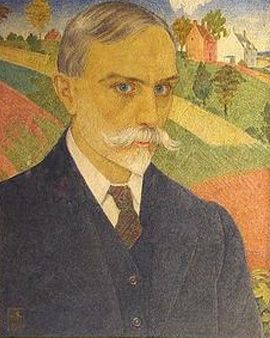


Joseph Edward Southall was born in Nottingham, England in a family belonging to the Quaker religious community. His father, a grocer, died just one year after his birth. The mother moved with her son to Birmingham to live with her family. After schooling in various Quaker schools, the young Southall worked in an architectural office and studied painting at the Birmingham School of Arts. He was very interested in the so-called Arts and Strengths Movement, which was very widespread between 1880 and about 1930. It mainly stood for a connection between art and traditional crafts, was for social and societal reforms and in principle against increasing industrialisation. The artist was an active socialist and pacifist.
At the age of 21 the artist travelled through France and Italy. He especially admired the Italian Renaissance artists. In Florence, Southall visited the chapel in the Medici's Palazzo, where he was particularly impressed by the tempera frescoes by Benozzo Gonzzolo, a painter living in the 15th century. But also the Italian architecture captivated him very much. Between the ages of forty and fifty, Joseph Edward Southall was at the height of his artistic career. During this time he created many large tempera paintings, mostly with mythological and religious themes, which were exhibited all over Europe, but also in the USA. He preferred the so-called egg tempera, and to produce it, Southall even kept his own chickens. Besides in tempera, the artist painted landscapes in watercolor and oil, but also many portraits. During this time he married his cousin Anna Elizabeth Baker at the age of 41. Both had decided to wait until Anna Elizabeth was no longer of childbearing age because of the existing blood relationship with the wedding, although they had been promised to each other since their youth.
With the outbreak of the 1st World War, the artist's productivity declined sharply. He devoted himself more to the anti-war struggle, wrote brochures and drew caricatures that appeared in books and magazines. After the war, Southall was also often occupied with more artistic and craft work. He designed decorations for furniture and, together with his wife, also designed the frames for his paintings himself. At the age of 76 the artist had to undergo an operation from which he never fully recovered. He died at the age of 83 in his home in Birmingham.

Joseph Edward Southall was born in Nottingham, England in a family belonging to the Quaker religious community. His father, a grocer, died just one year after his birth. The mother moved with her son to Birmingham to live with her family. After schooling in various Quaker schools, the young Southall worked in an architectural office and studied painting at the Birmingham School of Arts. He was very interested in the so-called Arts and Strengths Movement, which was very widespread between 1880 and about 1930. It mainly stood for a connection between art and traditional crafts, was for social and societal reforms and in principle against increasing industrialisation. The artist was an active socialist and pacifist.
At the age of 21 the artist travelled through France and Italy. He especially admired the Italian Renaissance artists. In Florence, Southall visited the chapel in the Medici's Palazzo, where he was particularly impressed by the tempera frescoes by Benozzo Gonzzolo, a painter living in the 15th century. But also the Italian architecture captivated him very much. Between the ages of forty and fifty, Joseph Edward Southall was at the height of his artistic career. During this time he created many large tempera paintings, mostly with mythological and religious themes, which were exhibited all over Europe, but also in the USA. He preferred the so-called egg tempera, and to produce it, Southall even kept his own chickens. Besides in tempera, the artist painted landscapes in watercolor and oil, but also many portraits. During this time he married his cousin Anna Elizabeth Baker at the age of 41. Both had decided to wait until Anna Elizabeth was no longer of childbearing age because of the existing blood relationship with the wedding, although they had been promised to each other since their youth.
With the outbreak of the 1st World War, the artist's productivity declined sharply. He devoted himself more to the anti-war struggle, wrote brochures and drew caricatures that appeared in books and magazines. After the war, Southall was also often occupied with more artistic and craft work. He designed decorations for furniture and, together with his wife, also designed the frames for his paintings himself. At the age of 76 the artist had to undergo an operation from which he never fully recovered. He died at the age of 83 in his home in Birmingham.
Page 1 / 2






